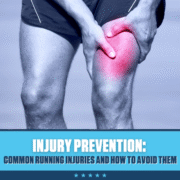Injury Prevention: Common Running Injuries and How to Avoid Them
 Running is one of the simplest and most rewarding ways to stay active, but like any repetitive sport, it comes with its fair share of injury risks. Whether you’re training for your first 5K, tackling a marathon, or simply running for fitness, knowing how to prevent injuries is just as important as logging your miles. The key is learning to listen to your body and taking steps to protect it before small aches turn into bigger setbacks. The good news? Most running injuries are preventable with the right mix of stretching, strengthening, and proper form.
Running is one of the simplest and most rewarding ways to stay active, but like any repetitive sport, it comes with its fair share of injury risks. Whether you’re training for your first 5K, tackling a marathon, or simply running for fitness, knowing how to prevent injuries is just as important as logging your miles. The key is learning to listen to your body and taking steps to protect it before small aches turn into bigger setbacks. The good news? Most running injuries are preventable with the right mix of stretching, strengthening, and proper form.
Common Running Injuries
Before we dive into prevention, let’s look at some of the most common injuries runners face:
-
Runner’s Knee (Patellofemoral Pain Syndrome): Pain around or behind the kneecap, often caused by weak muscles or improper tracking.
-
Shin Splints (Medial Tibial Stress Syndrome): Achy pain along the shin bone, usually from overtraining or improper footwear.
-
Plantar Fasciitis: Heel pain caused by irritation of the tissue along the bottom of the foot.
-
Achilles Tendinitis: Pain and stiffness in the tendon connecting the calf to the heel.
-
IT Band Syndrome: Tightness or pain on the outer side of the thigh and knee.
Now that we know the usual culprits, let’s talk about how to stay ahead of them.
Stretching for Injury Prevention
Dynamic stretching before runs and static stretching after can keep muscles flexible and joints mobile. A few key moves to add to your routine include:
-
Leg swings: Loosen hips and hamstrings.
-
Walking lunges: Warm up quads and glutes.
-
Calf stretches: Relieve tightness that can lead to Achilles issues.
-
Hip flexor stretches: Counteract sitting and prevent IT band pain.
Think of stretching as routine maintenance for your body—it helps keep everything moving smoothly.
Strengthening to Stay Strong
Strength training is often overlooked by runners, but it’s one of the best ways to prevent injury. Strong muscles absorb impact, stabilize joints, and correct imbalances. Focus on these areas:
-
Glutes: Bridges, squats, and clamshells help support your hips and knees.
-
Core: Planks and dead bugs stabilize your entire body during runs.
-
Calves: Heel raises strengthen the lower leg and protect the Achilles.
-
Hips: Side-lying leg lifts and resistance band walks improve stability.
Two to three short strength sessions a week can go a long way in keeping you injury-free.
Proper Form Matters
Good running form isn’t about perfection—it’s about efficiency and reducing stress on the body. Here are a few form tips to keep in mind:
-
Posture: Run tall with a slight forward lean from the ankles, not the waist.
-
Cadence: Aim for a quicker, lighter step (around 170–180 steps per minute) to reduce impact.
-
Foot strike: Land under your body, not way out in front.
-
Relaxation: Keep shoulders, arms, and jaw loose to avoid wasted energy.
Recording yourself running or working with a coach can help you spot and correct form issues.
 Final Thoughts
Final Thoughts
Running injuries can be frustrating, but with smart training, they don’t have to be inevitable. By mixing stretching into your warm-up and cool-down, adding strengthening exercises a few times a week, and focusing on proper form, you’ll not only reduce your risk of injury—you’ll also become a stronger, more efficient runner. Remember: consistency beats intensity, and prioritizing injury prevention today means more miles and more finish lines tomorrow.



